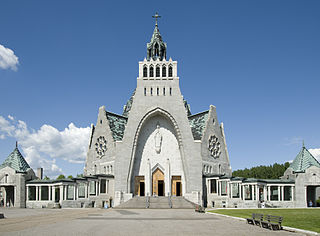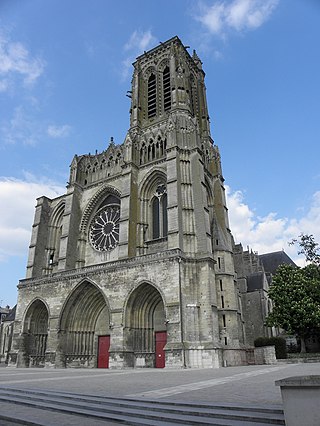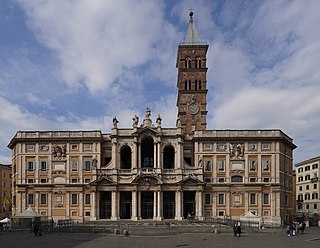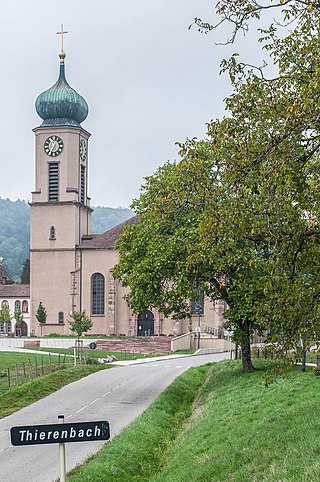
A shrine to the Virgin Mary, or Marian shrine, is a shrine marking an apparition or other miracle ascribed to the Blessed Virgin Mary, or a site on which is centered a historically strong Marian devotion. Such locales are often the destinations of Christian pilgrimages.

Aisne is a French department in the Hauts-de-France region of northern France. It is named after the river Aisne. In 2020, it had a population of 529,374.

Laon is a city in the Aisne department in Hauts-de-France in northern France.

The term Black Madonna or Black Virgin tends to refer to statues or paintings in Western Christendom of the Blessed Virgin Mary and the Infant Jesus, where both figures are depicted with dark skin. Examples of the Black Madonna can be found both in Catholic and Orthodox countries.

The Sanctuary of Our Lady of Lourdes is a Catholic Marian shrine and pilgrimage site dedicated to Our Lady of Lourdes in the town of Lourdes, Hautes-Pyrénées, France. The sanctuary includes several religious buildings and monuments around the grotto of Massabielle, the place where the events of the Lourdes apparitions occurred in 1858, among them are three basilicas, the Basilica of Our Lady of the Immaculate Conception, the Rosary Basilica and the Basilica of St. Pius X, respectively known as the upper, lower and underground basilica.

Our Lady of Lourdes is a title of the Virgin Mary. She is venerated under this title by the Roman Catholic Church due to her apparitions that occurred in Lourdes, France. The first apparition of 11 February 1858, of which Bernadette Soubirous told her mother that a "Lady" spoke to her in the cave of Massabielle while she was gathering firewood with her sister and a friend. Similar apparitions of the "Lady" were reported on 18 occasions that year, until the climax revelation in which she introduced herself as: "the Immaculate Conception". On 18 January 1862, the local Bishop of Tarbes Bertrand-Sévère Laurence endorsed the veneration of the Blessed Virgin Mary in Lourdes.

The Basilica of Notre-Dame de Fourvière is a minor basilica in Lyon, France. It was built with private funds between 1872 and 1896 in a dominant position overlooking the city. The site it occupies was once the Roman forum of Trajan, the forum vetus, thus its name.

The Basilica of Notre-Dame-du-Cap is a minor basilica in Trois-Rivières, Quebec, Canada. It is Canada's national shrine to the Blessed Virgin Mary, and one of the country's six national shrines. Each year, the site is visited by thousands of Catholic pilgrims.

The Basilica of Notre-Dame, Boulogne, otherwise the Basilica of Our Lady of the Immaculate Conception, is a minor basilica located in Boulogne-sur-Mer in the Pas-de-Calais département of northern France. The basilica, a prominent landmark of the city with its 101 metres (331 ft) high dome, was built between 1827 and 1875 on the site of the medieval cathedral of Boulogne: the basilica is still known locally as the "cathedral", although the present church has never had that status.

The Diocese of Soissons, Laon, and Saint-Quentin is a Latin Church diocese of the Catholic Church in France. The diocese is suffragan to the Archdiocese of Reims and corresponds, with the exception of two hamlets, to the entire Department of Aisne. The current bishop is Renauld Marie François Dupont de Dinechin, appointed on 30 October 2015. In 2022, in the Diocese of Soissons there is one priest for every 5,594 Catholics.

Saint-Étienne-le-Laus is a commune in the Hautes-Alpes department in southeastern France.

Catholic Marian churches are religious buildings dedicated to the veneration of the Blessed Virgin Mary. These churches were built throughout the history of the Catholic Church, and today they can be found on every continent including Antarctica. The history of Marian church architecture tells the unfolding story of the development of Catholic Mariology.

The Basilica of Our Lady of Tongre is a Roman Catholic parish church and minor basilica in Tongre-Notre-Dame, Chièvres, Belgium. The shrine is small, yet rich in historical significance.

The Basilica of Our Lady of Scherpenheuvel is a Roman Catholic parish church and minor basilica in Scherpenheuvel-Zichem, Belgium. The church was consecrated in 1627 and raised to the status of a minor basilica in 1922. It is reputedly the most frequently visited shrine of pilgrimage in Belgium. While the cult on the Scherpenheuvel is older, its present architectural layout and its enduring importance are due to the patronage of the Archdukes Albert and Isabella and the Counter-Reformation.

Our Lady of the Cape is a title given to Mary the Mother of God in Cap-de-la-Madeleine, Quebec Canada. The title refers specifically to a statue of the Blessed Mother which is currently located in the Old Shrine.

The Basilica of Notre Dame of Geneva is a Roman Catholic church and Minor Basilica located in Geneva, Switzerland. It is dedicated to the Blessed Virgin Mary.

The Chartres pilgrimage, also known in French as the pèlerinage de Chrétienté, is an annual pilgrimage from Notre-Dame de Paris to Notre-Dame de Chartres occurring around the Christian feast of Pentecost, organized by Notre-Dame de Chrétienté, a Catholic lay non-profit organization based in Versailles, France. Although the pilgrimage has existed since 1983, the organization was not founded until 1991. There is also a pilgrimage in an opposite direction from Chartres to Paris called Pèlerinage de Tradition and organised by the Society of Saint Pius X

Basilicas are Catholic church buildings that have a designation, conferring special privileges, given by the Pope. Basilicas are distinguished for ceremonial purposes from other churches. The building need not be a basilica in the architectural sense. Basilicas are either major basilicas, of which there are four, all in the Diocese of Rome, or minor basilicas, of which there were 1,810 worldwide as of 2019.

The Basilica of Our Lady of Thierenbach is a Cluniac priory and minor basilica located in Jungholtz, in the Alasace region of France.
























